Complete Solutions to EXERCISE of chapter OBSERVING SPACE: TELESCOPES of Class 9 book with complete answers and questions
| Class 9 | PHYSICS |
| Chapter | OBSERVING SPACE: TELESCOPES |
| TARGET PUBLICATION | EXERCISE |
| Number Of Questions | 75 |
| Academic Year | 2023-24 |
Choose the correct alternative
Light is an ________wave.
View SolutionChoose the correct alternative
_______-telescopes are also known as visible radiation telescopes.
View SolutionChoose the correct alternative
The wavelength of visible light is between
View SolutionChoose the correct alternative
The images produced by refracting telescopes have errors of colours is also known as ________.
View SolutionChoose the correct alternative
Which waves are detected by GMRT?
View SolutionChoose the correct alternative
_______telescope has a mirror of diameter 94 inches and is orbiting at a height of 569 km from earth.
View SolutionComplete the paragraph
Select the appropriate options and complete the following paragraph.
(optical, X-ray, artificial, 1990, 1999, 2015, radio, 1969)
Hubble telescope is an _________telescope which was launched into space in _______.Chandra telescope is an _______telescope which was launched into space in ______.Astrosat is an _______satellite which was launched into space in _______.
View SolutionName the following
A special type of telescope used to receive radio waves emitted by the heavenly bodies.
View SolutionName the following
A telescope that is designed to observe remote X-ray emitting objects in space
View SolutionName the following
An optical telescope which uses a convex mirror, a concave mirror and a lens.
View SolutionName the following
The institute where the biggest optical telescope in India is situated.
View SolutionName the following
Indian scientist who have a certain X-ray telescope named after him.
View SolutionTrue or False.
If false, write the correct sentence
Galileo was the first scientist to use 4 telescope for space observation.
View SolutionTrue or False.
If false, write the correct sentence
Earth’s atmosphere allows almost all the X-rays coming from space.
View SolutionTrue or False.
If false, write the correct sentence
Newtonian telescopes are made using a Concave mirror, a plane mirror and a lens.
View SolutionTrue or False.
If false, write the correct sentence
Chandra telescope is a radio telescope.
View SolutionOdd one out
NASA, ISRO, GMRT, ARIES.
View SolutionOdd one out
Hubble, Chandra, GMRT, Astrosat
View SolutionComplete the analogy
Radiowaves: Longer than 20 centimetre::_______: Shorter than 3 picometre.
View SolutionComplete the analogy
Newtonian telescopes : concave mirror, a plane mirror and a lens ::________ ss: Convex mirror, a concave mirror and a Jens.
View SolutionMatch the following
Match the rediations in group 'A' with their wavelength range in group 'B'.
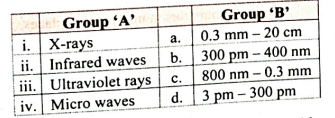
View SolutionMatch the following
Form pairs

View SolutionExplain the construction of Galileo's telescope.
View SolutionAnswer the following
Will one telescope be sufficient for us to observe space completely?
View SolutionAnswer the following
Why do we need different telescopes for the purpose?
View SolutionAnswer the following
Are telescopes installed even in space?
View SolutionAnswer the following
Give any two examples of optical telescopes.
View SolutionDiagram based question:
Which type of telescopes can be made using a concave mirror, convex mirror, plane mirror and a lens? Draw diagrams of these telescopes.
View SolutionExplain the construction of Galileo's telescope.
View SolutionAnswer the following
Write short note on Giant Meterwave Radio Telescope (GMRT).
View SolutionAnswer the following question:
What are the difficulties in using ground based optical telescope? How are they overcome?
View SolutionAnswer the following
Classify the following telescopes (Hubble telescope, GM RT, Chandra telescope, Newtonian telescope, Cassegrain telescope) depending upon the type of radiation
Visible radiation
View SolutionAnswer the following
Classify the following telescopes (Hubble telescope, GM RT, Chandra telescope, Newtonian telescope, Cassegrain telescope) depending upon the type of radiation
Radiowave radiation
View SolutionAnswer the following
Classify the following telescopes (Hubble telescope, GM RT, Chandra telescope, Newtonian telescope, Cassegrain telescope) depending upon the type of radiation
X-ray radiation
View SolutionAnswer the following
State the difference between EDUSAT and IRS.
View SolutionGive reasons
Why are reflecting telescopes preferred over refracting telescopes?
View SolutionAnswer the following question:
Why are optical telescope located in uninhabited places on mountains?
View SolutionAnswer the following question:
Why can an X-ray telescope not be based on the earth?
View SolutionDistinguish between Hubble telescope and Chandra telescope.
View SolutionComplete the given chart/table.
Complete the following table:
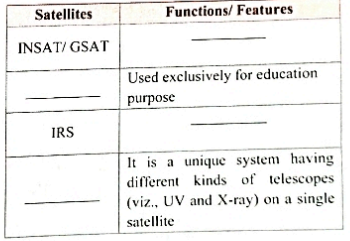
View SolutionQuestions based on diagram Study the figure and answer the following question
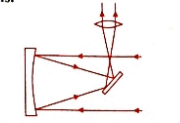 What type of telescope is shown in the figure?
What type of telescope is shown in the figure?
View SolutionQuestions based on diagram Study the figure and answer the following question
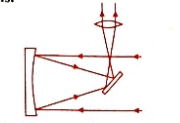 Label the main parts of the telescope.
Label the main parts of the telescope.
View SolutionQuestions based on diagram Study the figure and answer the following question
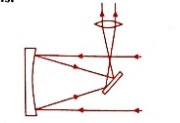 Which type of mirror does the telescope use?
Which type of mirror does the telescope use?
View SolutionQuestions based on diagram Study the figure and answer the following question
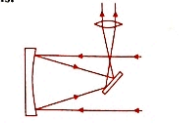 What other type of telescope uses a curved mirror?
What other type of telescope uses a curved mirror?
View SolutionQuestions based on diagram Study the figure and answer the following question
 Explain the working of the above telescope.
Explain the working of the above telescope.
View SolutionWhat is the difference between space and sky.
View SolutionWhat is meant by space observation? Why is it important?
View SolutionCollect information = ahowt —various observatorics in India and present it in the class.
View SolutionChoose the correct alternative.
__________satellite has Ultra-violet and X-ray detectors.
View SolutionChoose the correct alternative.
The position of the ________was useful for sea goers for navigation.
View SolutionChoose the correct alternative.
The telescope which uses radio waves having wavelength of about one metre coming from heavenly bodies is
View SolutionChoose the correct alternative.
The wavelength of ________is between 400 nm and 800 nm.
View SolutionAnswer the following.
Find the odd one out and justify your answer.
Newtonian, Cassegrain, Hubble, Chandra.
View SolutionAnswer the following.
Complete the given analogy.
Radio telescope : radio waves : , Chandra telescope:
View SolutionAnswer the following.
State true or false. If false, write the correct sentence.
The largest Indian optical telescope located at Bengaluru has a mirror with a diameter of 3.6 metre.
View SolutionAnswer the following.
Name the following.
An optical telescope which uses concave and plane mirror:
View SolutionGive scientific reasons
Chandra telescope cannot be based on the earth.
View SolutionGive scientific reasons
Why do we need different types of telescopes?
View SolutionAnswer the following.
Give detailed explanation of Hubble telescope.
View SolutionAnswer the following.
Write short note on Chandra telescope.
View SolutionAnswer the following.
Complete the following table:

View SolutionAnswer the following.
Explain Giant Meterwave Radio Telescope (GMRT) in detail.
View SolutionAnswer the following question:
What are the difficulties in using ground based optical telescope? How are they overcome?
View SolutionAnswer the following.
Observe the given figure and answer the questions.
 What type of telescope is shown in the figure?
What type of telescope is shown in the figure?
View SolutionAnswer the following.
Observe the given figure and answer the questions.
 Name the parts A and B shown in figure.
Name the parts A and B shown in figure.
View SolutionAnswer the following.
Observe the given figure and answer the questions.
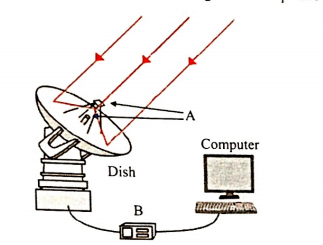 Which rays of spectrum can be detected using the telescope shown in figure?
Which rays of spectrum can be detected using the telescope shown in figure?
View SolutionAnswer the following.
Study the figure and answer the following question
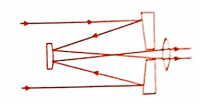 What type of telescope is shown in the figure?
What type of telescope is shown in the figure?
View SolutionAnswer the following.
Study the figure and answer the following question
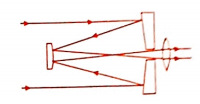 Label the main parts of the telescope.
Label the main parts of the telescope.
View SolutionAnswer the following.
Study the figure and answer the following question
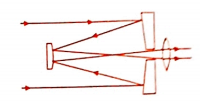 Which type of mirror does the telescope use?
Which type of mirror does the telescope use?
View SolutionAnswer the following.
Study the figure and answer the following question
 Which other type of telescope uses a curved mirror?
Which other type of telescope uses a curved mirror?
View SolutionAnswer the following.
Classify the following telescopes depending upon the type of radiations (Visible, Radiowave. X-ray).
Also state any one characteristic
Hubble telescope
View SolutionAnswer the following.
Classify the following telescopes depending upon the type of radiations (Visible, Radiowave. X-ray).
Also state any one characteristic
GMRT
View SolutionAnswer the following.
Classify the following telescopes depending upon the type of radiations (Visible, Radiowave. X-ray).
Also state any one characteristic
Chandra telescope
View SolutionAnswer the following.
Classify the following telescopes depending upon the type of radiations (Visible, Radiowave. X-ray).
Also state any one characteristic
Newtonian telescope
View SolutionAnswer the following.
Classify the following telescopes depending upon the type of radiations (Visible, Radiowave. X-ray).
Also state any one characteristic
Cassegrain telescope
View Solution
EXERCISE questions and complete solutions for chapter OBSERVING SPACE: TELESCOPES of TARGET PUBLICATION of Class 9